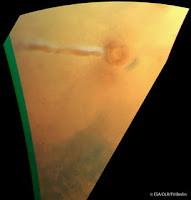 |
| Mars, as seen by the Hubble Telescope in 2018 during the opposition, when Mars is closer to Earth than average. Credits: NASA/ Hubble Telescope. |
 |
| Solar Eclipses at Mars with the planet's two moons. Credits: NASA/ Opportunity Rover |
Mars, the fourth planet from the sun, with a distance from the sun at 142 million miles or 1.53AU. Mars is almost half the size of Earth, with a diameter spamming 4,220 miles, and an axis tilted at 25 degrees. Mars is clearly red through a telescope, and when Mars is closer to Earth, you can see a red dot in the sky, thus Roman astronomers named the planet, God of War, Roman. The redness of the planet comes from rusts of the rich iron in the martian soil.
 |
| Panoramic Shot at the rim of the Endeavour Crater. Credits: NASA/Opportunity Rover |
 |
| Clouds around Olympus Mons. Credits: ISRO--India/ Mars Orbiter Mission |
Mars has an atmosphere 100 times thinner than Earth's and consists mostly of carbon dioxide, but despite the thinness of the the atmosphere, and the fact that the atmosphere consists mostly carbon dioxide, clouds and dusts storms exists on the planet. However, with an atmosphere this thin cannot keep temperatures like here on Earth, where or nights and days are not too cold, nor too hot, whereas Mars, nighttime temperatures can dip to -195 degrees Fahrenheit, and daytime temperatures at 70 degrees Fahrenheit.
 |
| Pictorial of how Curiosity lands on Mars. Credits: NASA |
Mars' atmosphere is very thin, from the fact that the planet does not have a magnetic field unlike Earth, and it leaves the atmosphere vulnerable to solar winds, and the interaction between the particles in the atmosphere and the solar wind, sputtering. Sputtering occurs when solar wind crashes into particles of air, knocking away the electrons, thus the particles becomes ions. With that these ions get carried by the magnetic field that comes with the solar wind. Some of these ions that gets carried away, also knocks other air particles out of the planet too, thus the reason why Mars has such a thin atmosphere.
 |
| False color image. It exposes the materials of the rocks. Credits: NASA/ Curiosity Rover |
No water has yet been seen on the planet directly, but, hints from the research and experiments, gives clues that water may be present on the planet. Data from pictures taken from landers, brines, slope lineae, return of radar to ground penetrating devices, and the geological changes over time, scientists hypothesize that water could have existed on Mars, and still is present, but is inside the planet, in higher regions, and/or the polar ice caps. This year (2018), NASA's Insight Mission will dig into the ground of Mars and see if there's water in the planet, and to see if it proves the scientists' hypotheses about the presence of water.
 |
| Heat shield used for Landing of the Opportunity Rover on the Martian surface. Credits: NASA/ Opportunity Rover |
Pictures of rovers tracks upon the Martian soils gives proof that the planet has some moisture, or at least, SOME. Now, there are sandstorms that cover the planet for long periods of time. How? Well, here's the reason. Mars is smaller, thus is has lesser pressure. At lower pressure, an object's boiling point lowers as well. The pressure at Mars is so low, that at its normal daily temperatures, the water boils, thus kicking some dusts up, and creating a large dust storm. Yet these sandstorms stay in the air for so long. Why? The atmosphere is very thin, so the water droplets in the air easily escapes the planet. With the water gone, the air is then very dry, thus the dusts easily stays in the atmosphere, until it slowly falls down.
 |
| Weird Cloud on Mars discovered recently, tracked by ESA probe. Credits: ESA/ Mars Express |
Although NASA has successfully delivered three rovers, landing in Mars is really hard. The thin atmosphere is enough to burn the falling object, but is so thin that retro rockets are needed to slow the payload down, or else the load will just smash onto the Martian dirt. Many space agencies have tried (including NASA) has miserably failed, but still some successes. For the record, more than half Mars missions had failed.
 |
| Spirit ready to roll onto the surface of Mars!! Credits: NASA/ Spirit Rover |
| Picture of Mars of 380,000 square km of surface. Credits: ESA/Mars Express |
For more detailed facts about water on Mars, go to:
https://linblogpage.blogspot.com/2018/09/are-bodies-of-water-on-mars.html
For more detailed facts about the atmosphere of Mars, go to:
https://linblogpage.blogspot.com/2018/09/does-air-exist-on-mars.html
GO TO:
Choi, Charles. Mars Facts: "Water and Robots on the Red Planet" October 10, 2017. Future PLC. Accessed at 31 October 2018 from
https://www.space.com/47-mars-the-red-planet-fourth-planet-from-the-sun.html/.
Bartels, Meghan. "Mars' South Pole May Hide A Large Underground Lake" July 25, 2018. Future PLC. Accessed at October 28, 2018 from
https://www.space.com/41272-mars-liquid-water-below-ice-cap.html/.
"Mars Today: Robotic Exploration" May 4, 2018. NASA. Accessed on October 25, 2018 from
https://www.nasa.gov/mission_pages/mars/main/index.html/.
"Mars Facts" NASA. Accessed on October 22, 2018 from
https://mars.nasa.gov/allaboutmars/facts/#?c=inspace&s=distance/.
Comments
Post a Comment